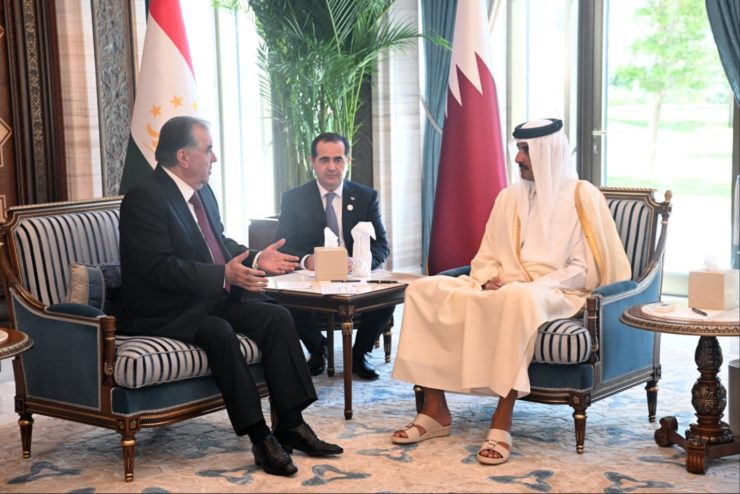
On 22 January 2024, Tajikistan’s President Emomali Rahmon concluded his state visit to Qatar. On that day, he held talks with Sheikh Tamim bin Hamad Al-Thani and the Qatari Minister of Trade and Industry, after which Rahmon held talks with representatives of Qatari business.
The Tajik President proposed to his Qatari counterparts the establishment of a joint investment fund as a new mechanism to ensure economic partnership between the two countries. Such bilateral funds are active in Central Asia: examples include the Russian-Kyrgyz Development Fund, the Uzbekistan-Kazakhstan Fund, as well as the investment fund of Kazakhstan and Saudi Arabia.
To further elaborate the details of cooperation between the two countries in various spheres, the President of Tajikistan proposed to his Qatari counterparts to set up a joint working group.
Energy, light industry, food, mining and pharmaceuticals, transport, agriculture and tourism were identified as the most promising sectors for bilateral co-operation. It is obvious that Tajikistan is searching for access of national products to new markets: Tajikistan’s negative trade balance is incompatible with its development plans in the coming years. In particular, the republic is interested in exporting agricultural products to Qatar, along with introducing the country’s advanced technologies to its enterprises. One of the promising areas of co-operation between the two countries in the field of industry and mining, the President of Tajikistan sees in the joint development of lithium deposits associated with the production of electric cars in the country. According to E. Rahmon, Tajikistan possesses two main components of the raw material base for this production – lithium and aluminium.
The topic of creating new transport corridors was discussed separately – discussion of promising highways and routes linking Central Asia and the Gulf monarchies is consistently on the agenda of Qatar’s negotiations with the Central Asian republics, which can get the shortest access to ocean highways within the framework of these projects. At the same time, Qatar, along with other Gulf countries, is looking forward to the creation of a new promising route that will link it with China and East Asia.
The export of labour from Tajikistan is also an important item on the agenda of bilateral relations: in February last year, a meeting of the joint committee on labour was held, and in 2019, the countries signed a provision on the conditions of importing labour from Tajikistan. It is possible that this topic was touched upon this time as well, although not directly reflected in the official reports on the talks.
At the same time, it seems remarkable that the “green agenda”, currently dominating not only in the international community as a whole, but also in similar negotiations between the countries of Central Asia and the Middle East, is absent from the negotiations. Tajikistan does not demonstrate the inherent interest of the countries of the region in the creation of solar and wind energy using Middle Eastern funds. Obviously, this is due to Dushanbe’s reliance on hydropower, which even without alternative energy requires huge sums of money – just think of the billions of dollars that Tajikistan is still looking for to complete its largest project in the sector, the Rogun hydropower plant.
The visit resulted in the signing of a number of notable agreements, including a programme of cooperation between the two countries’ Foreign Ministries for 2024-2026 and a joint memorandum between Tajikistan’s Ministry of Trade and Economic Development and the Qatar Free Economic Zones Authority. However, one should not expect a breakthrough in the signing of agreements on trade and economic cooperation quickly – a joint committee specially formed for this purpose will start searching for promising and mutually beneficial projects in the near future.
Qatar has been rapidly developing partnerships with most Central Asian countries in recent years. In June 2023, the Emir of Qatar visited Uzbekistan and Kazakhstan, and last July he attended the first Central Asia-GCC summit. The Emir of Qatar has also paid an official visit to Dushanbe twice, in 2019 and 2023. This process fits into the context of both the general increase in the Gulf countries’ trade, economic and transport and infrastructure interest in Central Asia, and the general activation of major global players in the region.
Thus, this visit by the head of Tajikistan to Qatar is an example of the dynamic development of partnership between the Gulf countries and Central Asia. It is obvious that Tajikistan seeks to attract investments from the Middle East in its economic, energy and transport projects, following the example of Kazakhstan and Uzbekistan, which have already succeeded in this endeavour. At the same time, the importance of transit issues in the bilateral discussion demonstrates the interest of the two countries in promoting continental transport routes.
Boris KUSHKHOV, Department of Korea and Mongolia, Institute of Oriental Studies, Russian Academy of Sciences. Especially for online magazine “New Eastern Outlook”
